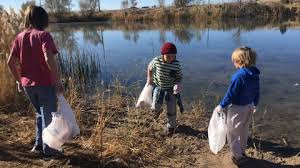
Fighting Freshwater Pollution around the United States
The U.S. boasts a rich tradition of freshwater fishing, but this pastime faces growing threats from pollution, habitat degradation, and invasive species. Recognizing the urgent need for restoration, nationwide cleanup efforts are underway. Key among these is the restoration of watersheds, where organizations work to undo damage from industrial pollution, reviving natural habitats for diverse fish species. Invasive species, particularly the Asian carp in the Mississippi River basin, pose a significant threat. Conservation groups actively engage in removal programs, emphasizing the importance of preventing their spread to other waterways. Local lakes advocate responsible boating to curb this threat, urging boaters not to transplant Asian carp. Implementing and maintaining these goals has become a federal focus as well.
Responsible Practices
Responsible fishing practices continue to play a vital role in conserving freshwater ecosystems. Anglers, supported by organizations like the Trout Unlimited and Natural Wildlife Federation, have embraced catch-and-release policies, respecting size and bag limits, and using barbless hooks to minimize the impact on fish populations. These measures have helped ensure the sustainability of freshwater fisheries. Federal and state governments have invested in clean water initiatives to reduce pollution from agricultural runoff, industrial discharges, and sewage. The Clean Water Act and similar regulations have been instrumental in promoting the cleanliness of water bodies. Along with the Clean Water Act, a lot of focus has been put into rehabilitating damaged natural habitats. Damaged habitats, whether from mining, development, or erosion, can severely impact fish populations. Organizations like the National Fish and Wildlife Foundation have been at the forefront of rehabilitating these habitats for young fish.
Public Education
Giving the public information about the best way to preserve local areas has also improved the health of lakes and rivers because it stops freshwater pollution at the source. Raising public awareness about the importance of freshwater ecosystems and sustainable fishing practices is key to the industry’s recovery. Various educational programs, workshops, and community outreach efforts aim to instill a sense of responsibility and stewardship among anglers and the general public. The government has also gotten involved with the mission to keep our waters clean by joining with local communities. They have begun implementing litigation to protect against invasive species. One of the most promising aspects of recent clean-up efforts in the fishing industry is the collaboration between government agencies, conservation organizations, local communities, and anglers. This united front creates a strong foundation for lasting change and sustainable management of freshwater resources.
Conclusion
In conclusion, recent clean-up efforts in the U.S. freshwater fishing industry are crucial. They preserve natural beauty, biodiversity, and reduce pollution. Actions include restoring watersheds, removing invasive species, promoting sustainable fishing, ensuring clean water, rehabilitating habitats, educating the public, and reviving native species. This collaborative effort offers hope for the future. Through perseverance of all groups involved freshwater fishing can be as sustainable as everAnglers, conservationists, and communities unite to protect freshwater resources, fostering industry revival. To conclude, the determination of these efforts speaks to Americans’ appreciation for the environment and fishing’s role in their lives.
